Have you ever had fabric that was just a little too white? Maybe you’d prefer an item to be ivory or off-white and it’s stark white instead? Or maybe you want something to look a little more antique than it currently does. This happened to me and I looked to traditional fabric dye but there’s an even better, more fool-proof method: dying fabric with tea! My aunt who makes doll clothes for antique dolls showed me how to do this when I was a teenager. I’ve used the method a few times since then for small things like lace or socks. But lately I found myself needing to use this method on yards and yards of fabric and I had no idea how to go about doing this. But I have figured it out with great success! So if you have something large like curtains or a duvet cover or just yards of fabric, keep reading for my tutorial! It’s not hard at all. (For smaller items, reduce this recipe and dye your items in the sink.)
This all started when I decided to make some new curtains and reupholster two chairs for my living room. I ordered the fabric online (I even sent for swatches first) and really loved it when I got it. Upon holding it up in the living room, though, I realized that the white baseboards, crown moulding, bookshelves and even the frames of the chairs were all a very warm white. Not quite ivory but definitely not the stark, clear white of the fabric I had ordered. The fabric looked just awful with everything else! All in all I had ordered seventeen yards of fabric. There is no way I could have afforded to buy something different that matched better. Painting the bookshelves AND the baseboards AND the crown moulding AND the frames of the chairs was similarly out of the question. So dying the fabric was really my only choice.
Reading online, I knew that using tea would give me much more natural and gentle results than trying to use something like rit dye. But how to dye seventeen yards of fabric? I couldn’t find any online tutorials for that.
First let’s talk about fabric: you can use this method on most fabrics but natural fibers will pick up the color best: cotton and linen will work beautifully. Synthetic fabrics are a little more difficult; they resist color. Some fabrics will work OK, like polyester. They may just take some extra time in the dye bath. But nylon is a bear to work with. Still, you can try it and see how well it works for you. My fabric was upholstery weight cotton and it took the tea dye very well.
Not all tea is created equal. I’m not talking about the quality of tea, I’m talking about the color. The first time I tried to color some lace with tea, I used the only kind I had on hand: hibiscus tea. This made my lace a weird yellowish pink. Not good. I’ve also used teas that were more yellow. My fabric ended up a color that can only be described as “not quite potty trained”, if you know what I mean. We want tea that will leave our fabric a warm color. Not yellow, but not brownish either. Lots of people recommend black tea but I have found the best results with Lady Grey Tea. This is similar to Earl Grey but has some orange and bergamot which makes it a great color. I bought it at my local Safeway and it was nice and cheap. Plain old tea bags are what you want. NOT loose tea. Twenty tea bags should be plenty.
You can get it on Amazon too.
In addition to tea you must have rubber gloves! You’re going to be putting your hands into very warm water and you for sure need some gloves. Really!
The first step is to wash your fabric. This is especially important if your fabric is new, since newly manufactured items often have a protective coating which will keep the tea from penetrating properly. Also, wet fabric takes dye more evenly than dry fabric does. I know this seems weird and wrong but it’s true. So give your item a quick wash in the washing machine (detergent is fine but don’t use fabric softener). If your fabric can handle hot water, use it! Hot water also opens up the fibers for better absorption. If you are dying fabric that will be used for sewing, dye the fabric before you sew it. Cotton will absolutely for sure shrink about 5%.
If you’re dying fine lace or anything antique, hot water may not be the best idea. (Antique linen has almost certainly been washed in hot water in its lifetime so it should be Ok.) No matter what fabric you’re using, get it nice and wet before you dye it!
While your fabric is washing, brew your tea. You’ll need a nice big pot. Fill it with water and put it on to boil. Once it’s barely boiling, turn off the heat and add 20 tea bags.
Stir it from time to time until your water is very, very dark. About 15-20 minutes.
Remove all the tea bags with a slotted spoon.
Now fill up your bathtub about a third of the way full with the hottest water that comes out of your faucet. Pour the tea water into the tub.
Its going to look crazy dark but don’t panic. Tea dyes slowly and gently.
Now put your wet fabric into the tub. You might momentarily freak out and wonder if this is a huge mistake. Totally normal.
Now comes the part that will make you feel like a pioneer:
Spend about five minutes swirling the fabric around in the tub. Try to get all the fabric under the water, then set the timer for 15 minutes. You can leave and go do something else until the timer rings. Then come back and swirl the fabric around for a few minutes, get as much fabric under the water as you can and set the timer for another 15 minutes. The idea is to make sure all the fabric spends as much time in the dye as possible so that the color looks even.
Repeat this as often as it takes to get the fabric the shade you like. I had my fabric in the tub for about an hour total (you’re results will probably differ due to the heat of the water, the composition of your fabric and the strength of your tea). Remember that the fabric will appear a little darker when it’s wet. The color changes so gently that it’s hard to see that it has changed much at all. If you have a swatch of the original fabric handy, it can be helpful.
Once you’ve decided that the fabric looks good, it’s going to need another spin in the washer. You don’t want tea residue rubbing off everywhere, right? Put the fabric back in the washer for a quick rinse and spin on hot (no detergent necessary).
After it’s been washed, hang it up to dry. This can be interesting if you’ve got seventeen yards like I did. I had it draped all over the bathroom and it took a whole day to dry.
After it’s dry you will absolutely need to iron it. Again, no fun if you have yards and yards.
After you’re all done your fabric should be the lovely off-white color you were hoping for! The picture at the very beginning of this post shows the two fabrics that I bought (11 yards of the buffalo checks for the chairs, six yard of the spots for the curtains). Originally these two fabrics were the exact same shoe of white. I dyed them in separate batches, starting with the spots. You can see the contrast between the off-white of the spotted fabric and the pure white of the checks. The spotted fabric looks a lot creamier than the checks. Once I was done, though, they both ended up the same warm white which turned out to be the perfect shade for my living room.

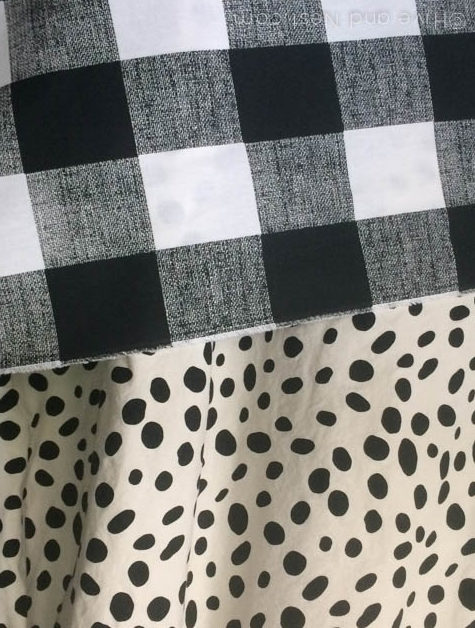
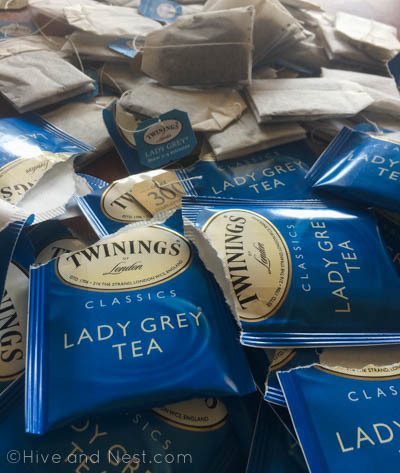


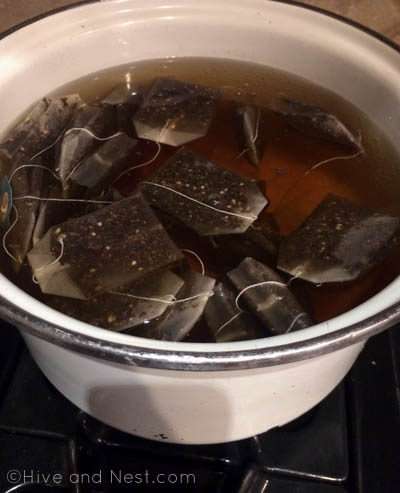

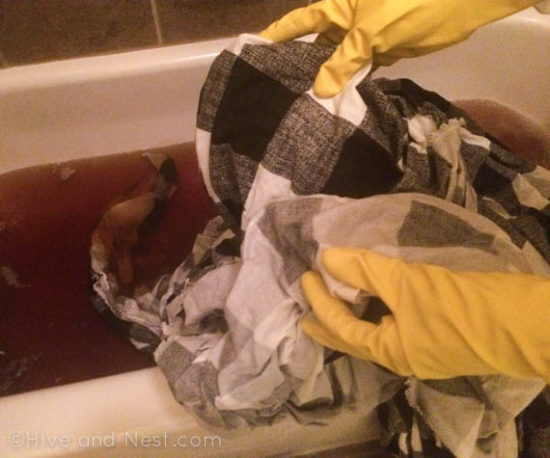

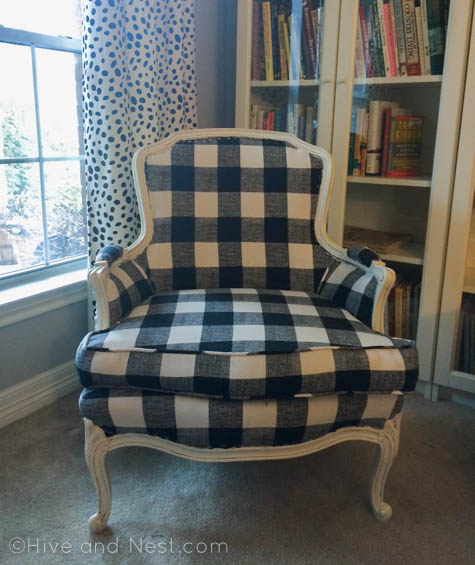
Thank you! I have done tea dyes before, but not on yards and yards. Excited.
Okay, I’m trying it! I bought 3 very long white cotton shower curtains. They are very very white, almost a little bluish next to my white fixtures, white tub, off white tile and Swiss coffee walls. Praying they will just be dulled a little but still look “white”!! Dang I forgot a before pic to compare🙄
would this work on white, polyester sheer curtains to turn them into ivory?
Thank you,
Polyester doesn’t take dye as well but I’d definitely try it.
thank you I could not find an exact match for my linen Draperies. I had to do two rounds of this tea dying, but I got it exactly right thank you thank you thank you so much.
thank you so much for this! do you know if this works with cold water as well (or maybe warm)? I have a sofa slipcover that is meant to be washed cold only and I’m worried it will shrink too much if I use hot water…
Should be ok. I’d do lukewarm. It opens up the fibers without causing shrinkage.
What about drying in the dryer
Definitely not. Unless it’s polyester, which won’t take the dye well to begin with.